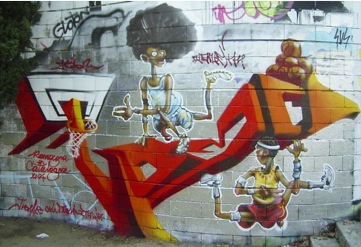


Basketball falls under the territory/invasion games category. The specific aim in the territory/invasion games category is to invade an opponent’s area to score. In order to accomplish this aim, students need to understand the rationale of off the ball movements and build this aspect first before they work on skill execution in order to generate the most success. As such we prioritized tactical awareness and decision making as well as skill execution in our lesson plans. Therefore, a major focus of our lesson plans was around movement. We used a format that followed a game, practice, game sequence. This format is successful as it allows students to discover what movements and skills are required to accomplish the task first. After this discovery, engaging questions that prompt the student’s discovery as well as isolated practice is optimal. Following practice, students are now ready to put their practiced skills into a modified game situation (exaggeration or representation game forms). An example of a simply modified game is endball; we used this game to conclude our first lesson.
Our four lesson plans focused on passing (moving into space to receive a pass), dribbling (eluding defenders by moving into space), Shooting (executing a jump shot by moving into space), and Lay-up shots (executing a lay-up with defensive pressure by moving into space). In our lesson plans we highlighted the importance of within-task modifications as well as progressions for students of varying levels. For example during tail tag students can shorten or lengthen their tag depending on their ability. For each lesson plan we followed a simple to complex guideline in terms of progressions. This not only intuitively makes sense, it sets children up for success before exposing them to more complex pressure. For example, we chose to teach the set shot before the jump shot. By giving students confidence in their ability to perform a set shot, when defensive pressure is applied they will ready to introduce a jump into their shot in order to be successful.
When creating a lesson plan, it is important to pay attention to all four learning domains: psychomotor, cognitive, social and affective (Metzler, 2005). We prioritize this premise and thus to ensure optimal learning we made sure to take into account all these domains in our lesson plans. As development of the social domain parallels, progress in the affective domain we combined these two domains in order to simplify.
The psychomotor domain covers off-the-ball movements and on-the-ball skills (skill selection and skill execution) (Griffin, Mitchell and Oslin, 1997). We thoroughly covered the psychomotor domain throughout our lesson plans as we emphasized this criteria during all games and skills. For example, our students could select to use the off the ball movement such as a V- cut to get open to receive a pass. They would then select to move into the triple threat position and square up to the basket. They would then execute this on-the-ball skill by stepping up to the proper triple threat position.
The social domain develops personal and social behavior (socialization and cooperation) and the affective domain covers respect, enjoyment and self-expression (Griffin, Mitchell and Oslin, 1997). We stimulated the social/affective domain in our lesson plans by promoting the constant change of partners in class. By giving students the opportunity to work and learn from others they build on their social behavior and affective elements. By giving co-responsibility to each pair of students with the required equipment manager’s position, the social/affective domain was also developed. In doing so, students learned to take responsibility for things that did not belong to them. Giving responsibility to students to peer and self evaluate also contributed to this domain.
The cognitive domain encompasses knowledge and understanding; the students’ ability to approach tactical problems with articulated solutions (Griffin, Mitchell and Oslin, 1997). In our lesson plans an example of how we promoted this domain is through creating tactical awareness problems and following these problems with prompting questions that stimulated decision making. For example, “Josh. in the game we just played (monkey in the middle) when would you perform a bounce pass, when the defender is very close to you and your teammate is directly behind him, or when the defender is in the deny position on your teammate? Why?” By not asking open ended questions and ensuring to use a student’s name, one will avoid silence from the students as a response. The student’s self-evaluations, peer evaluations, and their personal learning journals following class also stimulate students’ to think, and are a useful tool to further promote this domain.










